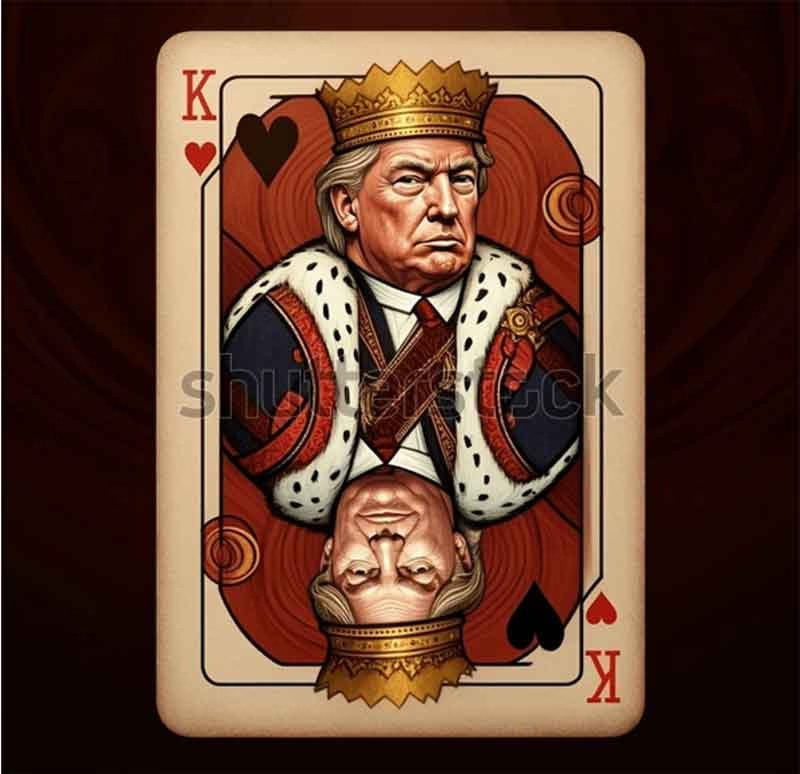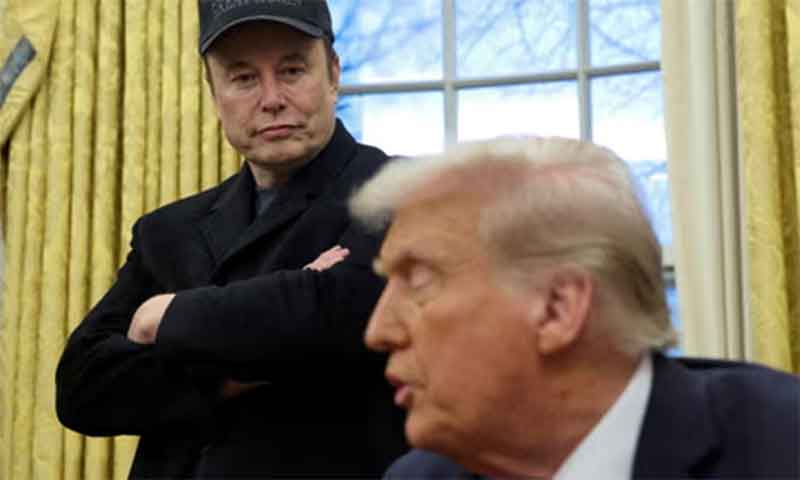
As West Asia erupts under the strain of imperialist interventions, the flames of external conflict are mirrored by a slow, internal combustion within American democracy itself. The nation finds itself caught in a grim tension, between the fire of external war and the tightening grip of internal authoritarianism. Domestically, the United States is witnessing one of the starkest unravelling of its democratic institutions in recent decades. What was once upheld as a global model of liberal democracy now borders on tragic parody. Massive protests against Donald Trump, ranging from major demonstrations in Los Angeles, New York, and Chicago to smaller uprisings in over 2,000 cities, have coalesced under a name laced with bitter irony: “No Kings.” The symbolism is striking, especially when read alongside Michel Foucault’s observation that “we still have not cut off the head of the king” (Foucault 1978: 88—89). Foucault notes that despite the passage of centuries and radical shifts in the form and function of governance, the image of power remains haunted by monarchical spectres. Even in supposed republics, political thought continues to revolve around the figure of sovereignty, legality, and violence as if the king still looms above the polity. Today’s American presidency, particularly under Trump, seems to embody this spectral return. His use of executive fiat, disregard for institutional checks, obsession with loyalty, and militarization of dissent are all symptoms of a deeper failure to displace the sovereign archetype. The protests erupting across the U.S. are not only a rejection of a particular regime but an eruption against a centuries-old political theology in which democracy too often masks a sovereign will to dominate.
This internal authoritarian drift is not merely a domestic phenomenon. It is deeply entangled with the United States’ imperial posture abroad, where the same logic of unilateral power and domination is projected onto the global stage. The much-celebrated majesty of U.S. soft power has, in reality, always been anchored in its military dominance and Europe’s colonial legacy, unlike the soft power traditions of China or Indian-Buddhism, which have historically derived their influence more from cultural depth and ethical-philosophical foundations. The Iran-Israel disputes, which escalated into open warfare following Israel’s anti-diplomatic offensive last week, did not arise in isolation. It is the direct outcome of a series of aggressive and undiplomatic manoeuvres by the United States under both the first and second Trump administrations. To fully grasp the roots of this confrontation, one must recognize the decisive role the U.S. has played in intensifying tensions across the Middle East. By consistently backing Israel’s military assertiveness, dismantling diplomatic avenues, withdrawing from multilateral peace initiatives, issuing unilateral threats against Iran, and aiding Israel’s brutal campaign in Gaza, the U.S. has laid the groundwork for the present crisis. Through continuous arms support and political cover, Washington empowered Israel to pursue a strategy of escalation, fully aware that Iran possesses the capacity to retaliate. This transition from proxy hostilities to direct confrontation has been engineered, in large part, by American-Israeli collusion. Whether intended to shift global attention away from the humanitarian catastrophe in Gaza or to provide a political diversion for Trump amidst mounting domestic turmoil, the outbreak of war reflects a calculated venture into the machinery of global necropolitics, a venture in which the U.S. is not a passive observer but the central architect.
The protests in California, particularly those ignited by Trump’s aggressive actions against immigrants, academic freedom, civil liberties, and the erosion of institutional impartiality, have become a powerful expression of widespread public anxiety over the creeping authoritarianism of the American state. These demonstrations, often framed by protesters as a defines of the Constitution itself, have been met with escalating state violence. Rather than engaging with dissent democratically, Trump has chosen a path of force, authorizing and even encouraging the use of police violence to quell opposition. His decision to deploy military units to suppress civilian protests has only intensified public outrage. What began as a response to brutal immigration raids in Los Angeles quickly evolved into a nationwide movement against the administration’s broader assault on democratic rights. Across numerous protest sites, law enforcement has resorted to excessive force, including tear gas, chemical irritants, rubber bullets, and stun grenades, against largely peaceful demonstrators.
In one widely circulated incident during a live news broadcast, a female journalist covering the protests from a safe distance was shot in the leg with a rubber bullet. The injury caused her to collapse and scream in pain, even though she was clearly identifiable as press and posed no threat. This moment, captured on camera, has come to symbolize the reckless and punitive nature of the police response, highlighting the erosion of press freedom and the growing normalization of unprovoked violence against civilians. It requires no further illustration to prove the irresponsibility and lack of accountability of the security forces acting under federal direction. Such scenes have become increasingly common under Trump’s second term, reinforcing fears that democratic dissent is being criminalized and militarized. The state’s response to peaceful protest reveals not just the fragility of democratic institutions, but the willingness of the executive to bypass them entirely in favour of direct, coercive control.
Hundreds of protesters have been arrested under sweeping federal directives that effectively bypass the authority of individual U.S. states, raising serious constitutional concerns. The deployment of military-grade force in civilian spaces, including armoured personnel carriers, surveillance drones, low-flying helicopters, and riot-control units, has stunned much of the American public. These scenes, once associated with foreign war zones, are now unfolding in the heart of U.S. cities. This unprecedented militarization of domestic protest zones reflects a sharp escalation in how dissent is treated under the Trump administration. By labelling peaceful demonstrations as “riots” and branding protesters as “domestic extremists,” the federal government has sought to delegitimize and criminalize dissent itself. In doing so, it has laid bare the increasingly fragile and performative nature of American democracy. What was once celebrated as a model of free expression and constitutional rights now appears to be a system where any challenge to executive authority can be met with overwhelming force and legal overreach. The authoritarian undertones of this response have alarmed civil rights organizations, legal scholars, and international observers alike, who see in these developments the slow but unmistakable unravelling of democratic norms in the United States.
Meanwhile, the Trump administration’s alliance with far-right extremist networks has grown increasingly visible, particularly in the southern states. Armed anti-immigrant vigilante groups have been aggressively mobilized and emboldened by the president’s rhetoric and tacit approval. These heavily armed civilian militias now patrol sections of the U.S.-Mexico border, engage in violent intimidation of migrants, and frequently intervene in protest spaces with the intent to provoke or suppress dissent. Disturbingly, reports have emerged of these groups coordinating with local law enforcement, creating a blurred and dangerous line between sanctioned state authority and extrajudicial violence. This convergence undermines the core democratic principle that separates civilian governance from militarized force. By enabling and encouraging these paramilitary formations, the Trump administration is steering the country toward a deeply troubling trajectory, one that echoes the logic of fascist death politics, where the use of force becomes normalized, ideologically driven, and unconstrained by legal oversight. This growing synergy between state institutions and armed civilian enforcers reflects not merely a breakdown of law and order but the strategic reconfiguration of power itself. In such a system, the rule of law is hollowed out and replaced by loyalty to authoritarianism, effectively dissolving the democratic architecture that once held the republic together.
Donald Trump’s recent declaration that he would terminate all federal contracts with Elon Musk, following Musk’s public criticism of Trump’s proposed AI regulations, serves as a stark reminder of how easily dissenting capital can be targeted and punished under the guise of executive authority in the United States. Musk, though controversial in his own right, expressed the views of a private individual and, not infrequently, of corporate capital. Trump, by contrast, is the elected head of state, making such retaliatory threats not only unprecedented, but deeply concerning for democratic governance.
This episode underscores a broader erosion of institutional checks and balances. The President’s willingness to use state power to penalize perceived disloyalty from private industry reveals the fragile condition of American democracy. What were once seen as strong and independent institutions, particularly the Senate and the House of Representatives, now appear increasingly ineffective in restraining executive overreach. Moreover, Trump’s broader economic interventions, including erratic tariff policies and the invocation of “national interest” to justify sweeping regulatory and trade decisions, point to a shift away from stable, rules-based economic governance. These are not simply policy moves; they are authoritarian signals. When executive decisions are made to settle personal or political scores, or to destabilize global markets for domestic populist gain, the line between democratic leadership and autocratic rule begins to blur. Trump’s actions reveal how, under the current system, a U.S. president can exercise extraordinary, and potentially dictatorial, powers, exposing structural vulnerabilities that many assumed American democracy had long outgrown.
The Trump administration’s escalating crackdown on critics of U.S. support for Israel has taken an alarming turn, with wide-ranging consequences for academic freedom. Mass revocations of student visas, prohibitions on political activism, the deployment of federal agents to university campuses to suppress pro-Palestinian expression, and financial pressure on institutions like Harvard represent a concerted attempt to silence dissent within higher education. These actions amount to a form of academic repression that some have likened to ideological cleansing. At the core of this campaign is the growing authoritarianization of education policy. Trump has openly targeted university departments that offer courses in racial theory, gender studies, and Middle Eastern politics, labelling them “anti-American” and calling for their defunding or closure. Several top universities have reported mounting federal pressure to revise their curricula and dismiss faculty members perceived to hold critical or left-leaning views. This direct intervention in academic content and personnel reflects a dangerous trend: the transformation of universities from spaces of critical inquiry into instruments of ideological conformity. By weaponizing federal authority to reshape intellectual life, the administration is undermining not only academic freedom but the democratic foundations of public education itself.
This is not merely government overreach, it represents a descent into what can only be described as fascist death politics, eroding the very foundation of democracy: intellectual and institutional autonomy. Perhaps the most emblematic example of this shift is Executive Order 14173, which rescinded long-standing non-discrimination requirements for federal contractors. By removing protections based on race, gender, and identity, this single executive action has reversed decades of hard-won civil rights progress.
What we are witnessing is a president using the mechanisms of democracy, executive power, constitutional ambiguity, and institutional inertia, to dismantle the very principles upon which that democracy was built. The trajectory is unmistakable: liberal democracy in the United States is being hollowed out and reconstituted as an illiberal regime, increasingly open about its authoritarian impulses.
For decades, the United States positioned itself as the global arbiter of democratic values, often questioning the legitimacy of other nations while claiming moral authority through its Constitution, an instrument that promised checks and balances, institutional independence, freedom of speech, and protection for minorities. But under Trump’s leadership, the weaknesses of the very safeguards are being systematically exposed. Again, while invoking the rhetoric of promoting democracy abroad, particularly in relation to Iran, the U.S. government is using that same rhetoric to mask its support for war, distract from internal crises, and exploit Iran’s domestic vulnerabilities.
This contradiction reveals the structural flaw long embedded in the American political system: a presidency that can opportunistically wield near-unchecked power while retaining the appearance of constitutional legitimacy. In exposing this hitherto masked vulnerability, the Trump era has made clear that the spectre of authoritarianism was never entirely foreign to the American system, it was always a possibility waiting to be realized.
American democracy has long been upheld as one of the most enduring myths of the modern era, a myth sustained less by its internal realities than by the global acceptance of American military dominance and its projection of moral authority. For decades, the world was persuaded, often uncritically, to equate U.S. military and economic power with democratic legitimacy. But under Donald Trump, that carefully maintained illusion has begun to unravel. What has been revealed is not a model of participatory governance or constitutional balance, but a hollowed-out system increasingly shaped by authoritarian impulses, one that masks its internal contradictions beneath the language of freedom and the pursuit of imperial interests.
Trump’s presidency has laid bare the extent to which American democracy can be manipulated by a single executive figure, exposing its structural vulnerabilities and its capacity to serve elite and nationalist agendas. The erosion of civil liberties, the militarization of dissent, and the politicization of institutions have shown that the U.S. political system, when pushed, can veer dangerously close to autocracy, all while retaining the symbolic trappings of democratic rule. Nowhere is this clearer than in the ongoing proxy war between Israel and Iran, where U.S. backing of Israeli aggression highlights the convergence of imperial ambition and authoritarian practice. The war is not merely a regional conflict; it is a manifestation of how the American state apparatus operates abroad in ways that mirror its internal descent. The support for Israel’s escalating military campaign, despite global condemnation and humanitarian catastrophe, is a stark reminder that U.S. foreign policy continues to function as a tool of geopolitical control, cloaked in the language of security and democracy promotion. In this context, Trump has not simply disrupted American democracy, he has exposed it. He has revealed the ideological machinery behind it: a system that can suspend rights, suppress dissent, and wage war under the pretence of liberty. The world is now seeing with greater clarity that American democracy, far from being a universal ideal, has often served as a rhetorical cover for imperial power and authoritarian governance.
Subscribe to Our Newsletter
Get the latest CounterCurrents updates delivered straight to your inbox.
Reference
Foucault, M. (1978). The history of sexuality: Volume I: An introduction (R. Hurley, Trans.). Pantheon Books.
T T Sreekumar, Ph.D, Professor | Department of Communication, School of Interdisciplinary Studies, Director (i/c), Educational Multimedia Research Center (EMMRC), The English and Foreign Languages University, Hyderabad














































